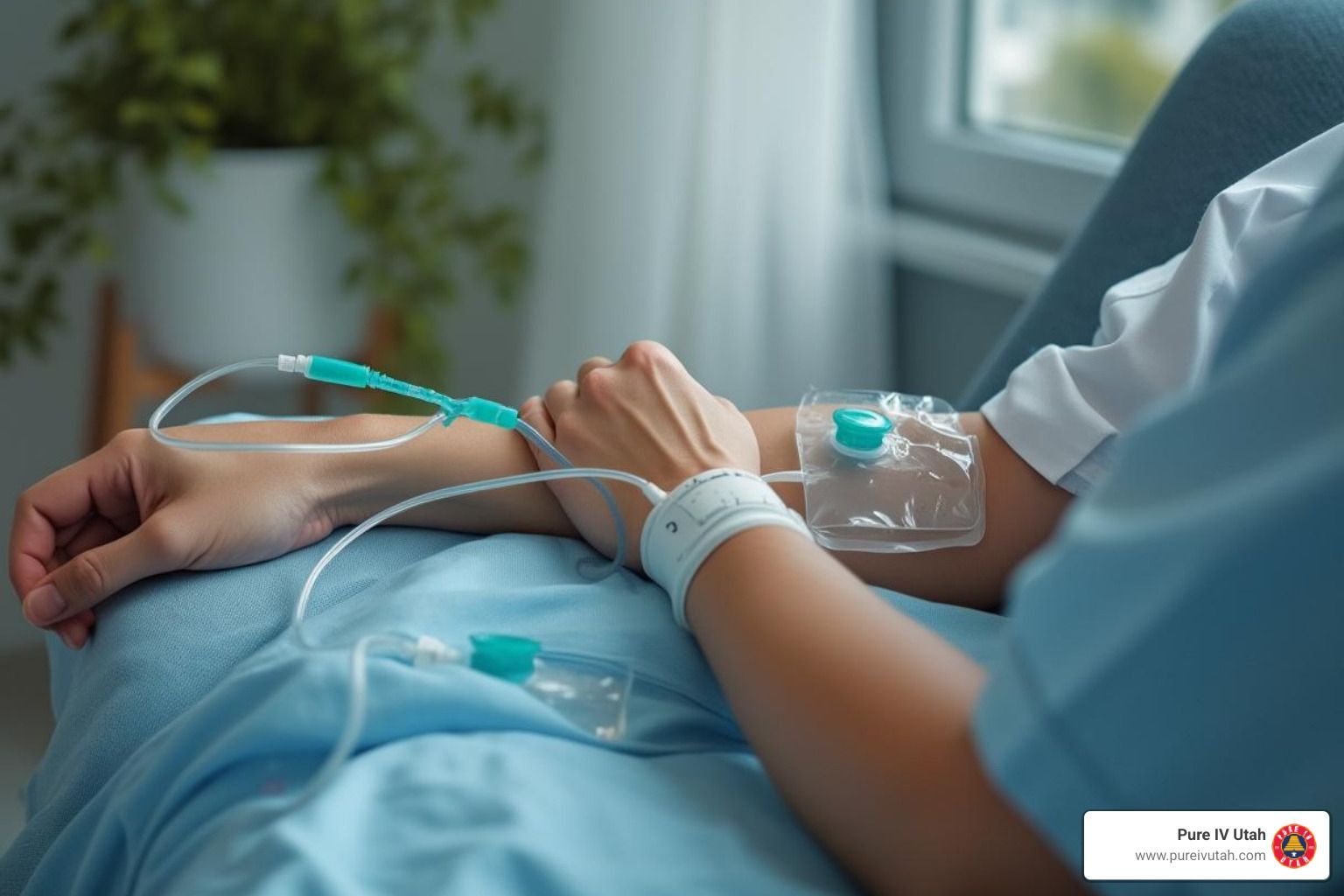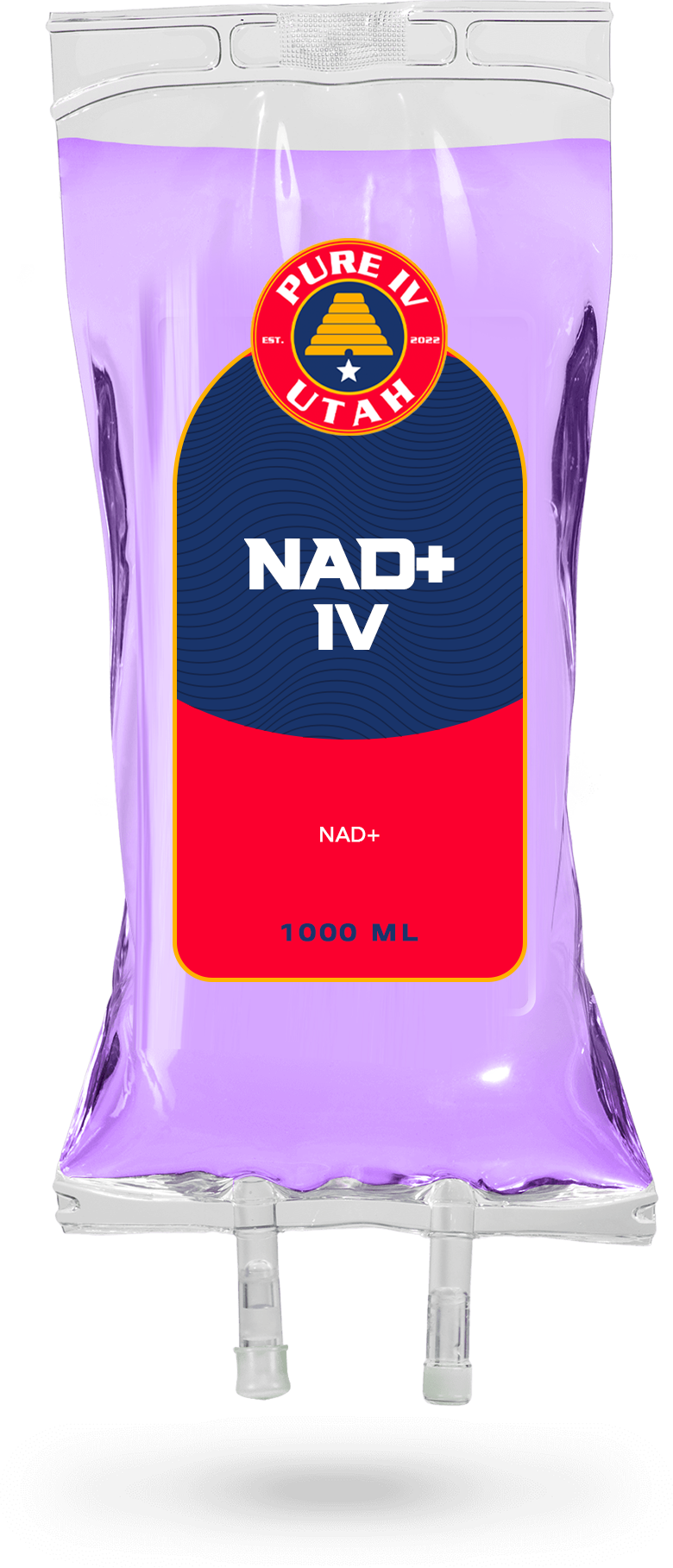Intravenous Therapy Made Simple (No Medical Degree Required!)

Medically reviewed by Micaela Strevay, FNP-C, PMHNP-BC
Joseph Lopez • June 30, 2025
Table of Contents
Why Understanding Intravenous Therapy Matters for Your Health
Intravenous therapy is a medical treatment that delivers fluids, medications, and nutrients directly into your bloodstream through a vein. This method bypasses your digestive system, allowing for 100% absorption and faster relief from dehydration, illness, or nutrient deficiencies.
Quick IV Therapy Facts: - What it is: Direct delivery of fluids into your bloodstream - How it works: Catheter inserted into vein, connected to IV bag - Time needed: 30-60 minutes for most treatments - Common uses: Dehydration, hangovers, altitude sickness, immune support - Benefits: Faster absorption than oral supplements, immediate hydration
Whether you're dealing with altitude sickness in Utah's mountains, recovering from travel fatigue, or seeking immune support during flu season, IV therapy offers a convenient solution. The process is straightforward - a licensed nurse inserts a small catheter into your arm and connects it to a bag containing the fluids or nutrients your body needs.
Mobile IV services have made this treatment more accessible than ever. Instead of waiting hours in a clinic, you can receive professional IV therapy at home, your office, or even your hotel room.
I'm Joseph Lopez from Pure IV Utah , and as a co-founder of a premier mobile IV therapy provider, I've witnessed how intravenous therapy can quickly restore health and energy for busy professionals, travelers, and families throughout Utah.

Quick intravenous therapy terms: - intravenous rehydration solution - iv infusion for dehydration
Why This Guide Matters
Understanding intravenous therapy basics helps you make informed decisions about your healthcare and know what to expect if you ever need treatment. We've designed this guide to be beginner-friendly while focusing on safety.
Many people feel anxious about IV therapy simply because they don't understand the process. Once you learn the basics, you'll realize it's a straightforward, well-established medical procedure that's been safely helping people for over 150 years.
What Is Intravenous Therapy?
Intravenous therapy offers a direct route to relief by delivering fluids, medications, and nutrients straight into your bloodstream through a vein. Whether you're feeling drained after a long flight or dealing with a stubborn hangover, IV therapy bypasses your digestive system completely.
The beauty of this approach is 100% bioavailability. While your stomach might be queasy or your intestines aren't absorbing nutrients properly, IV therapy delivers exactly what your body needs directly where it's needed most.
Intravenous therapy has deep medical roots. In 1832, Dr. Thomas Latta pioneered IV saline during a cholera epidemic in Britain, saving lives and laying the groundwork for modern medicine. By the early 1900s, hospitals were regularly using IV therapy, and today about 90% of hospital patients receive some form of IV treatment.
IV Basics Everyone Should Know
When someone mentions a catheter versus cannula , they're talking about parts of the same system. The catheter is the complete insertion device, while the cannula is the flexible tube that stays in your vein during treatment.
Venous access depends on your needs. Peripheral lines access veins in your arms or hands through a small insertion. Central lines are for intensive medical situations requiring access to larger veins near your heart.
Gauge choice uses a backwards numbering system - smaller numbers mean larger catheters. An 18-gauge catheter is bigger than a 22-gauge. For most hydration treatments, we use 18-20 gauge catheters for excellent flow rates while keeping you comfortable.
Main Uses & Indications
Dehydration is the most common reason people seek IV therapy today. IV fluids restore your body's water and electrolyte balance much faster than drinking fluids.
Medication delivery through IV ensures drugs reach your system quickly and completely. Antibiotics, anti-nausea medications, or pain relief work more effectively when delivered directly into your bloodstream.
Blood transfusions represent the life-saving side of IV therapy, delivering crucial blood products that restore health.
Parenteral nutrition helps patients who can't eat normally, delivering complete nutrition directly into the bloodstream.
Contrast media for medical imaging relies on IV delivery to help doctors see internal structures on CT scans and MRIs.
Types of IV Fluids & Medications
When receiving intravenous therapy , all IV solutions fall into three main categories: crystalloids, colloids, and blood products.
Crystalloids are the clear, simple solutions that handle most hydration needs. Colloids contain larger molecules that stay in your bloodstream longer. Blood products are actual blood components used in medical emergencies.

Crystalloids: The Workhorses
Crystalloids are the most common IV fluids. These clear solutions contain small molecules that dissolve completely in water, making them safe and effective for most situations.
Normal saline (0.9% sodium chloride) has the same salt concentration as your blood, keeping your cells stable. It's the go-to choice for basic rehydration.
Lactated Ringer's solution contains a balanced mix of sodium, chloride, potassium, calcium, and lactate that closely mimics what's naturally in your body. Many providers prefer this for patients needing aggressive fluid replacement.
Dextrose solutions add sugar, providing both hydration and calories when you haven't been eating well.
Maintenance fluids replace what you normally lose daily, while resuscitation fluids restore volume when you're significantly dehydrated.
Colloids & Specialty Solutions
Colloids contain larger molecules that stay in your bloodstream longer than crystalloids, useful for specific medical situations but more expensive.
Albumin is a protein solution that helps maintain blood pressure, particularly valuable for patients with liver disease or severe burns.
Hypertonic saline contains higher salt concentrations and is reserved for specific medical emergencies, particularly brain swelling.
Cost matters: crystalloids typically cost under $5 per bag, while colloids can run $50-200 per bag. For most wellness needs, crystalloids work perfectly well.
Scientific research on IV fluid choice confirms that normal saline and lactated Ringer's are equally effective for most hydration needs.
How IV Therapy Is Administered Safely
When it comes to intravenous therapy , safety follows time-tested protocols refined over decades. Whether in a hospital or at home, the same rigorous standards apply.

Safe IV therapy starts with aseptic technique - keeping everything sterile. Your nurse thoroughly washes hands, puts on fresh gloves, and cleans your skin with antiseptic.
IV delivery works like filling a bathtub. A bolus is like turning the faucet on full blast, while a continuous infusion provides steady, controlled flow over 30-60 minutes. Most wellness treatments use the steady approach.
Smart pumps automatically calculate the perfect drip rate and sound alarms if anything seems off. Essential equipment includes your IV catheter , IV tubing , the IV bag , and an infusion pump .
Step-by-Step: Starting an IV
Your nurse begins by examining your arms to find the perfect vein - looking for veins that are straight, bouncy, and easily visible, usually in your forearm or hand.
Gauge selection uses reverse sizing - smaller numbers mean larger catheters. Your nurse picks the right size based on your treatment needs and vein size.
The tourniquet goes around your upper arm, temporarily restricting blood flow to make veins more visible. Your nurse cleans your skin with antiseptic and lets it dry completely.
During insertion , you'll feel a quick pinch similar to getting blood drawn. The insertion happens at a shallow angle and takes just seconds.
Finally, your nurse flushes the catheter with saline to ensure proper positioning, then secures it with medical tape. The entire process takes 2-3 minutes.
Monitoring & Maintenance
Once your intravenous therapy is flowing, monitoring begins. Your nurse becomes your IV guardian, watching several key things throughout treatment.
Flow rate monitoring ensures treatment infuses at exactly the right speed. Your nurse continuously checks your IV site for swelling, redness, or catheter displacement.
How you're feeling matters just as much as technical aspects. Your nurse regularly asks about comfort and watches for response changes. Everything gets carefully documented .
Scientific research on infection prevention shows that proper hand hygiene and aseptic technique are your best protection against infections.
Risks, Complications, and How to Avoid Them
No medical procedure is 100% risk-free, and intravenous therapy is no exception. However, serious complications are rare, and most issues are minor and easily managed.

Infiltration is the most common complication, occurring when IV fluid leaks into surrounding tissue instead of staying in your vein. You'll notice puffiness, coolness, and discomfort around your IV site. This happens in 10-25% of peripheral IV lines but is usually just annoying, not dangerous.
Phlebitis means your vein has become irritated and inflamed, showing as redness, warmth, and tenderness along the vein.
Fluid overload can happen if you receive too much fluid too quickly, potentially straining your heart and lungs, especially in older patients or those with heart conditions.
Electrolyte imbalances occur when your body's balance of sodium, potassium, and other minerals gets disrupted, causing symptoms from mild nausea to heart rhythm changes.
Air embolism is extremely rare with modern equipment and safety protocols.
Early Warning Signs & Management
Pay attention to these warning signs: sudden swelling or pain at your IV site, redness or warmth spreading from the insertion point, shortness of breath or chest tightness, rapid heartbeat, severe nausea, or dizziness and confusion.
Healthcare providers follow the "Stop-Lift-Document" protocol when complications arise: immediately stop the infusion, lift the affected limb to reduce swelling, and document what happened.
Catching problems early allows quick resolution of what starts as minor discomfort.
Special Safety Tips for Home Infusions
Mobile intravenous therapy maintains safety standards outside clinical settings through extra attention to detail.
Licensed nurse oversight is non-negotiable. Only registered nurses or paramedics under physician supervision should administer IV therapy. They carry emergency supplies and know exactly what to do if something unexpected happens.
Emergency preparedness means your provider comes equipped with epinephrine for allergic reactions, backup supplies, and clear emergency protocols. They should know the nearest emergency room location.
Quality matters enormously. Trustworthy services use only FDA-approved medications from licensed pharmacies and should be transparent about safety protocols.
Special Situations & Trending Topics in Intravenous Therapy
Intravenous therapy requires special considerations for different populations and situations.

Pediatric patients require smaller catheter gauges (22-24 gauge) and fluid requirements calculated by body weight rather than standard adult dosing.
Geriatric patients often have fragile veins requiring gentler techniques and slower infusion rates to prevent fluid overload.
Patients with kidney or heart failure need careful monitoring, as simple hydration could cause serious complications.
Athletes face restrictions - the World Anti-Doping Agency prohibits IV injections over 100 mL per 12 hours for competitive athletes, except under medical exemptions.
IV Vitamin Therapy: Hype vs Evidence
The wellness industry has acceptd IV vitamin therapy, but let's separate marketing from science.
The Myers' Cocktail contains magnesium, calcium, B vitamins, and vitamin C. Developed in the 1970s, rigorous clinical trials studying its effectiveness remain limited.
Some evidence-based applications exist. IV magnesium sulfate shows promise for treating acute asthma in children. High-dose IV vitamin C is being studied in cancer care with mixed results.
Reality check: you might feel amazing after IV vitamin therapy, but rapid hydration could be doing most of the work, not expensive vitamins. When dehydrated, getting fluid into your system naturally makes you feel more energetic.
Scientific research on vitamin IV therapy suggests benefits may be more modest than marketing claims.
Can IV Therapy Be Done at Home?
Absolutely, but safety must come first. Mobile intravenous therapy brings hospital-level care directly to your location.
Proper safety requirements include licensed healthcare professionals, proper medical equipment, established protocols, quality medications from licensed pharmacies, and proper waste disposal.
Cost transparency matters. Mobile IV therapy typically ranges from $109-400 per session. Since insurance rarely covers wellness IV therapy, reputable providers give clear, upfront pricing.
The convenience benefits are life-changing: no waiting rooms, no driving when feeling terrible, and professional care in your comfortable space.
Frequently Asked Questions about Intravenous Therapy
Let me address common questions from patients considering their first intravenous therapy treatment.
Does an IV hurt more than a blood draw?
The initial insertion feels very similar to getting blood drawn - that familiar quick pinch when the needle goes through your skin. Most people are surprised it's less uncomfortable than expected .
The main difference is that an IV catheter stays in your arm for 30-60 minutes. Most patients forget it's even there once treatment begins.
Your nurse's experience makes a huge difference in comfort. If you have needle anxiety, mention it - we can use topical numbing cream or other comfort measures.
How long does a typical hydration drip take?
Most intravenous therapy sessions take 45-60 minutes from start to finish. This timing allows your body to properly absorb fluids without overwhelming your system.
A smaller 250 mL bag takes around 30 minutes, while a full liter may take 60-90 minutes. If you're severely dehydrated, we might slow the rate to prevent complications.
Complex treatments with multiple vitamins naturally take longer than simple saline hydration.
What if I have hard-to-find veins?
Experienced nurses have many tricks for accessing challenging veins. Warm compresses help dilate veins, good hydration makes them more prominent, and positioning changes use gravity to help fill veins.
When standard techniques aren't enough, we have advanced methods like ultrasound equipment to locate deeper veins and smaller catheter sizes for alternative sites.
Don't let concerns about difficult veins prevent you from getting needed intravenous therapy . Our nurses have successfully treated thousands of patients, including many who thought their veins were impossible to access.
Conclusion
You now have the knowledge to approach intravenous therapy with confidence. From understanding what goes into your body to recognizing warning signs, you're equipped to make smart healthcare decisions.
Intravenous therapy isn't mysterious - it's a time-tested medical treatment that's been helping people for over 150 years. Today, you don't need to sit in hospital waiting rooms to benefit from it.
Safety first is the most important principle. Whether dealing with dehydration, recovering from travel, or boosting energy levels, always choose licensed healthcare providers who follow proper protocols.
We've seen thousands of patients feel dramatically better after IV therapy in Utah. Proper hydration and targeted nutrients delivered through intravenous therapy can genuinely help you feel your best.
At Pure IV Utah, we believe healthcare should come to you. Our licensed nurses have administered thousands of safe, effective IV treatments across Utah - from Salt Lake City executives to Park City weekend warriors to families throughout the state.
Ready to experience the difference proper hydration can make? More info about mobile IV therapy is just a click away. Book your appointment online and find why so many Utahns trust us with their wellness.
Stay hydrated, stay healthy, and remember - you deserve to feel your absolute best.





